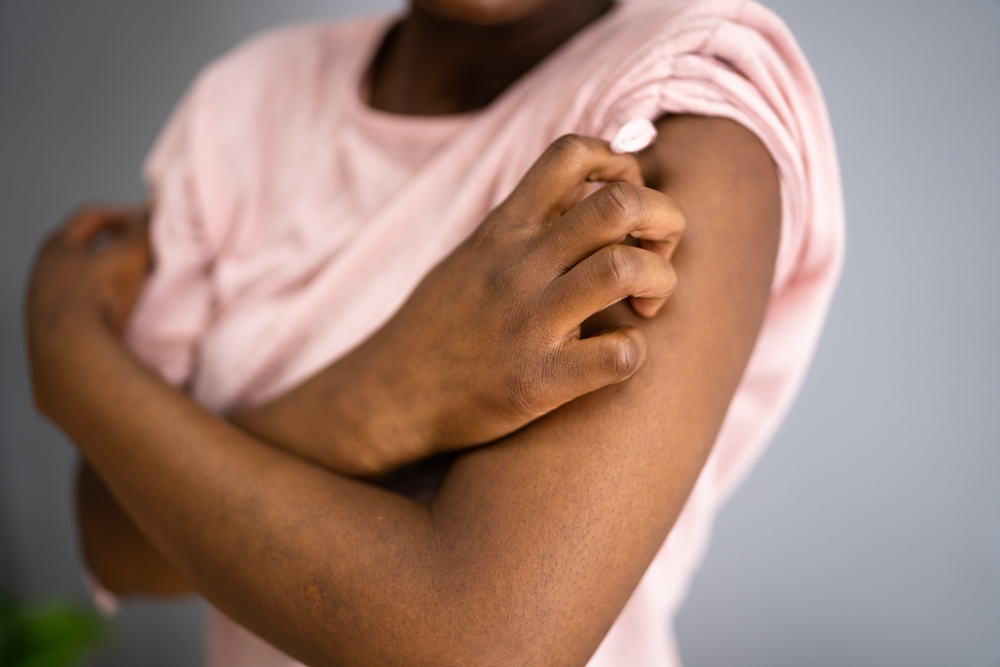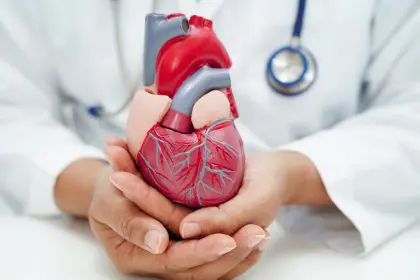That angry cluster of itchy red bumps might be more than just an annoying skin condition. While many skin irritations represent harmless reactions to environmental triggers, some persistent or unusual skin eruptions can actually serve as visible warning signs of underlying health issues that deserve medical attention. Your skin, as the body’s largest organ, often functions as an external indicator of internal processes gone awry, from digestive imbalances to autoimmune disorders to serious systemic diseases. Understanding the potential meanings behind different types of skin manifestations can help distinguish between a simple rash requiring basic care and a dermatological red flag that warrants further investigation. Learning to decode these skin signals might provide crucial early warnings that could significantly impact your health trajectory.
When harmless becomes potentially harmful
While many skin irritations resolve without consequence, certain characteristics or patterns suggest the need for professional evaluation. Recognizing these warning signs helps distinguish between minor annoyances and potentially serious conditions.
Duration serves as a primary differentiator between benign and concerning skin eruptions. Ordinary reactions to irritants, minor allergic responses, or simple heat rashes typically resolve within a few days to a week with basic care and trigger avoidance. When red bumps persist beyond two weeks despite appropriate home treatment, they’ve crossed an important threshold suggesting possible underlying conditions requiring evaluation. This timeline provides a practical rule of thumb for deciding when to seek professional assessment.
Distribution patterns provide important diagnostic clues that help distinguish serious conditions from simple rashes. Symmetrical rashes that appear in matching locations on both sides of the body often indicate systemic issues like drug reactions or autoimmune conditions. Linear arrangements might suggest contact with poisonous plants or external irritants. Rashes confined to sun-exposed areas frequently signal photosensitivity reactions related to medications or autoimmune disorders. Bumps that follow nerve pathways could indicate shingles, while those exclusively affecting skin folds suggest either fungal infections or conditions like inverse psoriasis.
Associated symptoms beyond the skin often provide crucial context for evaluating the significance of red bumps. When skin eruptions appear alongside fever, joint pain, persistent fatigue, swollen lymph nodes, unexplained weight changes, or digestive disturbances, they frequently represent manifestations of systemic conditions rather than isolated skin problems. These accompanying symptoms warrant prompt medical evaluation, as they suggest the skin changes represent just one component of a more complex health issue affecting multiple body systems.
Progression characteristics offer important insights into potential causes and severity. Rashes that spread rapidly, change appearance dramatically, or develop new features like blistering, scaling, or color changes after initial appearance often indicate active inflammatory or infectious processes that require medical assessment. Similarly, bumps that begin as one distinct type but transform into different skin manifestations over time frequently represent evolving conditions that benefit from professional diagnosis rather than continued self-treatment.
The bumps themselves provide visual clues through their specific characteristics. Particularly concerning features include purple or dusky red discoloration rather than bright inflammation, significant asymmetry in individual bump appearance, bumps that ulcerate or develop central depressions, raised borders with central clearing, or any that bleed easily with minimal trauma. These attributes appear more commonly in serious dermatological conditions and merit evaluation regardless of other factors like duration or distribution.
Recurrence patterns sometimes reveal important information about potential underlying causes. Skin eruptions that repeatedly appear in identical locations, especially with similar triggers each time, often indicate chronic conditions rather than random skin irritations. These cyclical patterns may correlate with stress periods, hormonal fluctuations, seasonal changes, or exposure to specific environments, providing valuable clues for identifying potential systemic contributions to skin manifestations.
The digestive connection hiding behind your skin
Among the most commonly overlooked contributors to chronic skin conditions lies the intimate connection between digestive health and skin manifestations. This gut-skin axis explains why persistent skin issues often reflect internal imbalances rather than simply requiring more aggressive topical treatments.
Food sensitivities frequently manifest through skin reactions occurring hours or even days after consumption, making the connection difficult to recognize without systematic tracking. Unlike immediate allergic reactions that trigger obvious responses, delayed sensitivity reactions may cause skin eruptions 24-72 hours after exposure as immune complexes form and circulate before eventually triggering cutaneous inflammation. This delayed timing often obscures the relationship between specific foods and resulting skin manifestations.
Intestinal permeability alterations, sometimes called “leaky gut,” allow partially digested food particles and bacterial components to enter circulation, triggering immune responses that frequently include skin manifestations. This increased permeability can result from factors including chronic stress, certain medications, alcohol consumption, and inflammatory diets. The resulting immune activation often produces widespread, seemingly random skin eruptions that resist conventional dermatological treatment while the underlying permeability remains unaddressed.
Microbiome imbalances within the digestive tract create another pathway for gut-related skin manifestations. The trillions of bacteria inhabiting your intestines influence everything from nutrient absorption to immune regulation to hormone metabolism, all of which affect skin health. Research increasingly demonstrates specific associations between altered gut bacterial populations and skin conditions including acne, rosacea, and various forms of dermatitis. These associations explain why courses of antibiotics frequently trigger skin eruptions by disrupting intestinal bacterial balance.
Inflammatory bowel conditions like Crohn’s disease and ulcerative colitis create systemic inflammation that commonly manifests through skin eruptions. Approximately 15% of patients with these digestive disorders develop characteristic skin manifestations, often appearing as red, tender nodules on the shins, painful mouth ulcers, or distinctive rashes. These dermatological signs sometimes appear before obvious digestive symptoms, potentially serving as early warning indicators of underlying bowel inflammation that warrants investigation.
Malabsorption issues create nutrient deficiencies that frequently appear first through skin changes. When the intestines cannot properly absorb essential nutrients like zinc, B vitamins, essential fatty acids, or fat-soluble vitamins, the skin often develops characteristic manifestations. These range from symmetrical red, scaly patches suggesting B vitamin deficiencies to poorly healing wounds indicating zinc insufficiency. The skin’s high metabolic demand makes it particularly vulnerable to nutritional inadequacies, often showing visible changes before other systems develop noticeable dysfunction.
Histamine intolerance represents another digestive-skin connection frequently overlooked in conventional dermatology. When the body cannot properly break down histamine from foods or produces excessive amounts internally, the resulting accumulation commonly triggers skin reactions including hives, flushing, and itchy red bumps that worsen after consuming histamine-rich foods like fermented products, aged cheeses, or certain vegetables. This mechanism explains why some people experience seemingly random skin eruptions that correlate with specific meals without representing true food allergies.
When your immune system attacks your skin
Autoimmune conditions frequently target the skin, creating distinctive patterns of inflammation that signal potential systemic disorders requiring specialized treatment approaches. These conditions deserve particular attention as early diagnosis often significantly improves long-term outcomes.
Psoriasis manifests beyond its characteristic silver-scaled plaques in varied presentations that patients and providers sometimes misidentify as simple rashes. Guttate psoriasis appears as small, drop-shaped red lesions scattered across the trunk and limbs, often following streptococcal infections. Inverse psoriasis creates smooth, red patches in body folds without the typical scaling. Pustular variants produce painful, pus-filled bumps that may appear exclusively on the palms and soles. All these forms represent autoimmune inflammation potentially associated with increased risks for cardiovascular disease, metabolic syndrome, and inflammatory arthritis, making accurate identification important beyond skin management.
Lupus creates several distinctive skin manifestations that often provide the first detectable signs of this serious autoimmune condition. The classic butterfly rash across the cheeks and nose represents the most recognized form, but other cutaneous lupus variants include raised, red, disc-shaped lesions that can lead to permanent scarring, and tiny red bumps on the knuckles that signal inflammatory activity. Since lupus can potentially damage organs including kidneys, heart, and brain, recognizing these characteristic skin signals allows for earlier intervention that may prevent serious complications.
Dermatomyositis announces itself through uniquely colored skin eruptions that herald potentially severe muscle inflammation. The distinctive purplish-red rash around the eyes, vibrant red patches over the knuckles, and violet discoloration on the upper chest represent cardinal signs of this autoimmune condition in which the immune system attacks both skin and muscles. These distinctive skin manifestations often develop before noticeable muscle weakness, providing crucial diagnostic clues that enable earlier treatment to prevent disability.
Vasculitis, inflammation of blood vessels, frequently becomes visible through characteristic skin manifestations before affecting other organs. These typically appear as palpable purpura, raised purple spots that don’t blanch when pressed, or as urticaria that persists in the same locations for more than 24 hours. These distinctive skin presentations signal potential inflammation affecting blood vessels throughout the body, including those supplying vital organs like kidneys, lungs, and nervous system. Recognizing these cutaneous signs allows for prompt evaluation that may prevent serious vascular damage.
Celiac disease, beyond its well-known digestive effects, creates distinctive skin manifestations in approximately 25% of cases. The most recognized form, dermatitis herpetiformis, produces intensely itchy, clustered red bumps and small blisters typically appearing on the elbows, knees, buttocks, and scalp. These symmetrical eruptions respond dramatically to gluten elimination, often improving long before intestinal healing completes. This skin-gut connection explains why some people with minimal digestive symptoms develop significant dermatological manifestations of celiac disease, potentially serving as their primary diagnostic indicator.
Scleroderma often presents initially through skin changes before developing its more serious internal complications. Early signs include puffy fingers that progress to skin thickening, especially noticeable around the fingers and hands. Other cutaneous manifestations include small, dilated blood vessels visible on the skin surface, particularly around the fingers, lips, and face. These dermatological changes may precede internal organ involvement by months or years, making their recognition crucial for early diagnosis of this potentially serious autoimmune condition.
When medications and treatments trigger skin reactions
Pharmaceutical reactions frequently manifest through distinctive skin eruptions that require differentiation from ordinary rashes. Recognizing these patterns helps identify potential medication triggers that may require adjustment.
Drug-induced eruptions follow characteristic timing patterns that provide important diagnostic clues. Most medication reactions develop within the first two weeks after starting a new drug, with particular concentration between days 7-10. This timing reflects the period required for the immune system to recognize and react to the medication as foreign. However, certain drug reactions develop only after prolonged exposure, particularly those involving medications like minocycline, hydralazine, or isoniazid that can trigger autoimmune responses with continued use.
Distribution patterns often suggest medication reactions rather than random skin irritation. Drug eruptions typically appear symmetrically across the body, frequently affecting the trunk before spreading to the extremities. Some medications produce highly distinctive patterns, like the “V” of the chest and upper back frequently affected in photosensitive drug reactions, or the predominance of skin fold involvement seen with certain chemotherapy agents. These characteristic distributions help distinguish drug-induced eruptions from other skin conditions.
Morphology, the specific appearance of individual lesions, provides important clues for identifying medication reactions. Morbilliform eruptions resembling measles represent the most common drug-induced pattern, appearing as widespread small red bumps that may merge into larger patches. Fixed drug eruptions create round, well-demarcated purplish patches that recur in identical locations with repeated drug exposure. DRESS syndrome produces distinctive facial swelling and widespread red patches, while Stevens-Johnson syndrome/TEN creates painful blistering of skin and mucous membranes.
Common culprits include predictable offenders that dermatologists immediately consider when evaluating potential drug eruptions. Antibiotics, particularly those in the penicillin, cephalosporin, and sulfonamide families, remain among the most frequent triggers. Anticonvulsants like carbamazepine and lamotrigine, allopurinol for gout, and various non-steroidal anti-inflammatory drugs also commonly trigger skin reactions. Newer biological medications and immune checkpoint inhibitors used in cancer treatment produce distinctive eruption patterns that require specialized management approaches.
Timing of discontinuation significantly impacts resolution patterns for medication-induced skin reactions. While some mild drug eruptions resolve despite continued medication use as the body accommodates to the drug, most require discontinuation for complete resolution. Timelines vary significantly based on the specific medication’s half-life and the reaction type, with simple morbilliform eruptions typically improving within days of stopping the triggering drug, while more severe reactions like DRESS syndrome may take weeks to resolve fully even after medication discontinuation.
Cross-reactivity between chemically similar medications creates important considerations when managing drug-induced skin eruptions. Patients who react to one medication often develop similar reactions to chemically related drugs, creating entire medication classes that require avoidance. Understanding these cross-reactivity patterns helps prevent recurrent reactions while still providing treatment alternatives for the underlying condition. Awareness of these relationships proves particularly important for antibiotics, anticonvulsants, and pain medications, where numerous options within related chemical families exist.
When infectious agents cause skin signals
Various infections create distinctive skin manifestations that often provide the first recognizable signs of the underlying condition. Identifying these characteristic patterns helps distinguish infectious causes from other sources of skin eruptions.
Viral exanthems produce distinctive skin patterns that sometimes allow specific viral identification based on cutaneous appearance alone. Measles creates a characteristic progression from face to trunk to extremities, while chickenpox produces lesions in various stages of development simultaneously. Fifth disease generates the distinctive “slapped cheek” appearance followed by lacy red patterns on the extremities. Hand-foot-mouth disease creates distinctive vesicles concentrated in specific anatomic locations identified in its name. These viral signatures help identify specific pathogens while also distinguishing viral causes from bacterial or allergic conditions.
Bacterial infections produce several characteristic skin patterns requiring prompt recognition. Streptococcal infections often create bright red, clearly demarcated patches with sandpaper-like texture, while staphylococcal presences typically form pustules or honey-colored crusted areas. More serious bacterial spread within skin layers manifests as rapidly expanding red, warm, painful areas that may track visibly along lymphatic channels. These bacterial signatures often require specific antibiotic approaches based on the likely organism suggested by the skin’s appearance.
Fungal infections create distinctive patterns of red, itchy bumps with characteristic distributions and appearances. Ringworm produces the classic expanding circular lesions with raised borders and central clearing, while yeast infections typically affect warm, moist body folds with bright red, sometimes satellite lesions at the periphery. Fungal involvement of nails or hair creates additional distinctive patterns that help identify the underlying cause. These fungal signatures often respond exclusively to antifungal treatments rather than the antibiotics or anti-inflammatory approaches used for other rash types.
Parasitic infestations produce highly distinctive skin manifestations with characteristic distributions and symptoms. Scabies creates intensely itchy, thread-like burrows often concentrated between fingers, on wrists, and in genital regions, typically worsening dramatically at night. Various lice species produce distinctive patterns of tiny red bumps concentrated in areas where the specific lice type preferentially lives, along with visible nits attached to hairs in the affected regions. These parasitic signatures require specific antiparasitic treatments rather than the approaches used for allergic or inflammatory skin conditions.
Systemic infections sometimes produce distinctive skin manifestations before other symptoms become apparent. Rocky Mountain spotted fever creates characteristic rashes beginning on wrists and ankles before spreading centrally, meningococcemia produces distinctive purplish spots that enlarge rapidly, and scarlet fever generates the “strawberry tongue” and sandpaper-textured body rash that provide important diagnostic clues. Recognizing these cutaneous clues to serious systemic infections allows for prompt intervention that can significantly impact outcomes for these potentially life-threatening conditions.
Timing patterns often help distinguish infectious causes from other sources of skin eruptions. Viral exanthems typically follow a predictable course appearing several days after initial symptoms like fever or respiratory complaints, while bacterial skin infections usually develop more rapidly with quickly expanding areas of involvement. Understanding these temporal patterns helps identify likely causes while also assessing the need for medical intervention based on the expected progression of specific infection types.
When to treat at home and when to seek help
Practical guidelines help determine when self-care suffices and when professional evaluation becomes necessary for skin eruptions. These approaches balance prudent self-management with appropriate medical attention.
Simple home care suffices for many minor skin irritations with low-risk characteristics. Rashes that appear after clear environmental exposures like new detergents, that cover limited body areas, that don’t involve the face or genital regions, and that respond to basic interventions often resolve without medical care. Appropriate home approaches include cool compresses, gentle cleansing, unscented moisturizers, and over-the-counter hydrocortisone for localized inflammation. These measures typically improve minor irritant reactions within several days when combined with avoiding the suspected trigger.
Warning signs that warrant prompt medical attention include several key features that suggest potentially serious conditions. These include rapidly spreading redness, particularly with warmth and pain, yellow or green discharge suggesting infection, blistering eruptions especially involving mucous membranes, association with high fever or significant systemic symptoms, and rashes that create perfectly circular lesions with raised borders. These characteristics suggest conditions that may require prescription medications, specialized testing, or monitoring for potential complications.
Chronic recurrent episodes deserve professional evaluation even when each individual occurrence seems minor. Patterns of repeated similar eruptions often indicate underlying conditions that benefit from comprehensive assessment rather than simply managing each episode separately. These recurrent patterns frequently reveal food sensitivities, autoimmune tendencies, or chronic infections that require specific identification and targeted management for long-term resolution rather than continued symptomatic treatment.
Diagnostic uncertainty represents another important reason for seeking professional evaluation. When home observation cannot reasonably determine whether a skin eruption represents a benign irritation or a more concerning condition, medical assessment provides important clarity. This uncertainty often arises with unusual distributions, atypical appearance, or confusing symptom patterns that don’t clearly match common benign conditions. Professional evaluation in these situations often prevents both unnecessary worry about minor conditions and dangerous delays in addressing serious ones.
Documentation before appointments significantly enhances diagnostic accuracy for skin conditions that fluctuate or evolve rapidly. Taking clear, well-lit photographs when skin manifestations appear at their most characteristic helps healthcare providers evaluate conditions that might look different by appointment time. Including multiple angles, close-up and distant views, and images taken in natural lighting provides the most useful documentation. These visual records prove particularly valuable for conditions that appear intermittently or change appearance rapidly with treatment attempts.
Preparation for dermatology visits enhances their diagnostic value through several important steps. Avoiding topical treatments for 24-48 hours before appointments allows providers to observe the natural appearance of skin conditions without treatment-induced changes. Bringing a comprehensive list of all current medications, recent medication changes, and previously tried treatments helps identify potential pharmaceutical triggers or treatment failures. Notes about timing patterns, associated symptoms, and suspected triggers provide crucial context that helps narrow diagnostic possibilities during limited appointment times.
Understanding when skin manifestations suggest deeper health issues and when they represent simple surface irritations helps strike the optimal balance between unnecessarily alarming yourself about minor skin concerns and recognizing important warning signs that warrant medical attention. With thoughtful observation of specific characteristics, patterns, and associated factors, you can better determine which skin changes deserve simple home care and which might be trying to tell you something more important about your health.















